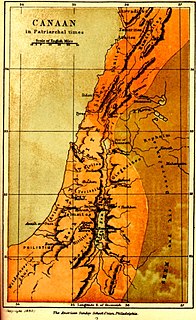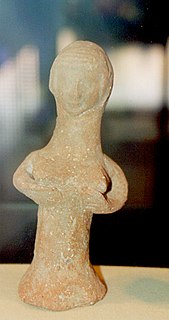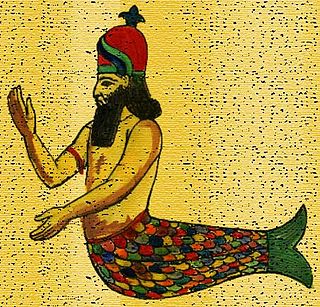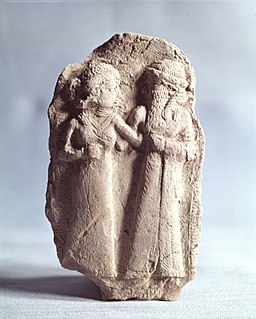 W
WCanaanite religion refers to the group of ancient Semitic religions practiced by the Canaanites living in the ancient Levant from at least the early Bronze Age through the first centuries of the Common Era.
 W
WAdonis was the mortal lover of the goddess Aphrodite in Greek mythology. In Ovid's first-century AD telling of the myth, he was conceived after Aphrodite cursed his mother Myrrha to lust after her own father, King Cinyras of Cyprus. Myrrha had sex with her father in complete darkness for nine nights, but he discovered her identity and chased her with a sword. The gods transformed her into a myrrh tree and, in the form of a tree, she gave birth to Adonis. Aphrodite found the infant and gave him to be raised by Persephone, the queen of the Underworld. Adonis grew into an astonishingly handsome young man, causing Aphrodite and Persephone to feud over him, with Zeus eventually decreeing that Adonis would spend one third of the year in the Underworld with Persephone, one third of the year with Aphrodite, and the final third of the year with whomever he chose. Adonis chose to spend his final third of the year with Aphrodite.
 W
WAfqa is a village and municipality located in the Byblos District of the Mount Lebanon Governorate, 71 kilometres (44 mi) northeast of Beirut in Lebanon. It has an average elevation of 1,200 meters above sea level and a total land area of 934 hectares. Its inhabitants are predominantly Shia Muslims.
 W
WAnat, Anatu, classically Anath is a major northwest Semitic goddess. Her attributes vary widely among different cultures and over time, and even within particular myths.
 W
WAsherah, in ancient Semitic religion, is a mother goddess who appears in a number of ancient sources. She appears in Akkadian writings by the name of Ašratu(m), and in Hittite as Aserdu(s) or Asertu(s). Asherah is generally considered identical with the Ugaritic goddess ʾAṯiratu.
 W
WAstarte is the Hellenized form of the Middle Eastern goddess Astoreth, a form of Ishtar, worshipped from the Bronze Age through classical antiquity. The name is particularly associated with her worship in the ancient Levant among the Canaanites and Phoenicians. She was also celebrated in Egypt following the importation of Levantine cults there. The name Astarte is sometimes also applied to her cults in Mesopotamian cultures like Assyria and Babylonia.
 W
WThe Baal Cycle is an Ugaritic cycle of stories about the Canaanite god Baʿal, a storm god associated with fertility. It is one of the Ugarit texts.
 W
WCanaanite religion refers to the group of ancient Semitic religions practiced by the Canaanites living in the ancient Levant from at least the early Bronze Age through the first centuries of the Common Era.
 W
WDagon or Dagan is an ancient Mesopotamian and ancient Canaanite deity. He appears to have been worshipped as a fertility god in Ebla, Assyria, Ugarit, and among the Amorites.
 W
WDanel, father of Aqhat, was a culture hero who appears in an incomplete Ugaritic text of the fourteenth century BCE at Ugarit, Syria, where the name is rendered DN'IL, "El is judge".
 W
WDumuzid later known by the alternative form Tammuz, is an ancient Mesopotamian god associated with shepherds, who was also the primary consort of the goddess Inanna. In Sumerian mythology, Dumuzid's sister was Geshtinanna, the goddess of agriculture, fertility, and dream interpretation. In the Sumerian King List, Dumuzid is listed as an antediluvian king of the city of Bad-tibira and also an early king of the city of Uruk.
 W
WʼĒl is a Northwest Semitic word meaning "god" or "deity", or referring to any one of multiple major ancient Near Eastern deities. A rarer form, ʼila, represents the predicate form in Old Akkadian and in Amorite. The word is derived from the Proto-Semitic archaic biliteral ʼ‑l, meaning "god".
 W
WHadad, Adad, Haddad or Iškur (Sumerian) was the storm and rain god in the Canaanite and ancient Mesopotamian religions. He was attested in Ebla as "Hadda" in c. 2500 BCE. From the Levant, Hadad was introduced to Mesopotamia by the Amorites, where he became known as the Akkadian (Assyrian-Babylonian) god Adad. Adad and Iškur are usually written with the logogram 𒀭𒅎 dIM—the same symbol used for the Hurrian god Teshub. Hadad was also called Pidar, Rapiu, Baal-Zephon, or often simply Baʿal (Lord), but this title was also used for other gods. The bull was the symbolic animal of Hadad. He appeared bearded, often holding a club and thunderbolt while wearing a bull-horned headdress. Hadad was equated with the Greek god Zeus; the Roman god Jupiter, as Jupiter Dolichenus; the Indo-European Nasite Hittite storm-god Teshub; the Egyptian god Amun.
 W
WThe Legend of Keret, also known as the Epic of Kirta, is an ancient Ugaritic epic poem, dated to Late Bronze Age, circa 1500 – 1200 BC. It recounts the myth of King Keret of Hubur. It is one of the Ugarit texts.
 W
WLotan is a servant of the sea god Yam defeated by the storm god Hadad-Baʿal in the Ugaritic Baal Cycle. possibly with the help or by the hand of his sister ʿAnat. Lotan seems to have been prefigured by the serpent Têmtum represented in Syrian seals of the 18th–16th century BC, and finds a later reflex in the sea monster Leviathan, whose defeat at the hands of Yahweh is alluded to in the biblical Book of Job and in Isaiah 27:1. Lambert (2003) went as far as the claim that Isaiah 27:1 is a direct quote lifted from the Ugaritic text, correctly rendering Ugaritic bṯn "snake" as Hebrew nḥš "snake".
 W
WMot was the ancient Canaanite god of death and the Underworld. He was worshipped by the people of Ugarit, by the Phoenicians, and also by the Hebrews of the Old Testament. The main source of information about his role in Canaanite mythology comes from the texts discovered at Ugarit, but he is also mentioned in the surviving fragments of Philo of Byblos's Greek translation of the writings of the Phoenician Sanchuniathon and also in various books of the Old Testament.
 W
WTannin or Tunnanu was a sea monster in Canaanite and Hebrew mythology used as a symbol of chaos and evil.
 W
WYahwism was the historic monolatristic/henotheistic worship of Yahweh in the ancient Israelite kingdoms of Judah and Israel (Samaria), Yahweh being one of the many gods and goddesses of the pantheon of gods of the Land of Canaan, the southern portion of which would later come to be called the Land of Israel. Yahwism thus evolved from Canaanite polytheism, which in turn makes Yahwism the monolatristic primitive predecessor stage of Judaism in Judaism‘s evolution into a monotheistic religion.